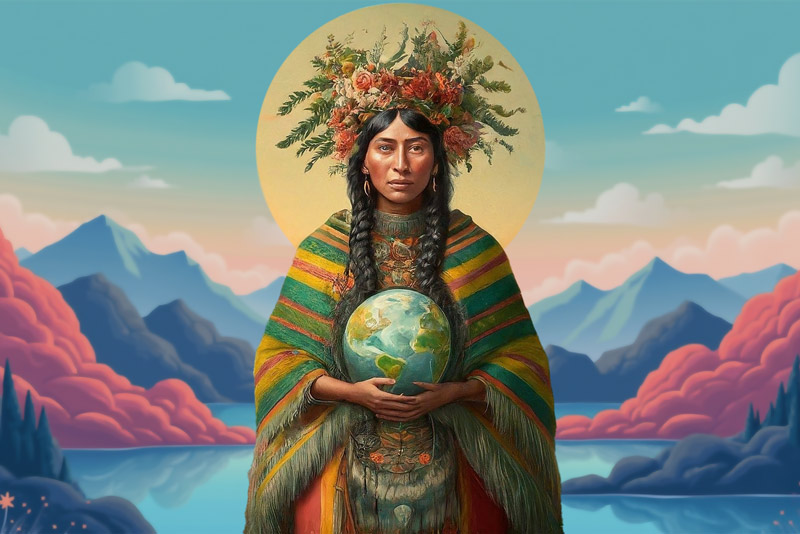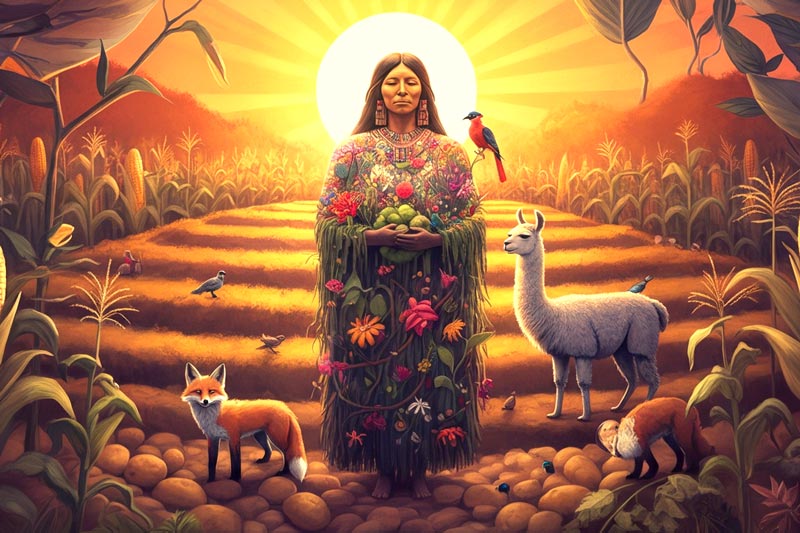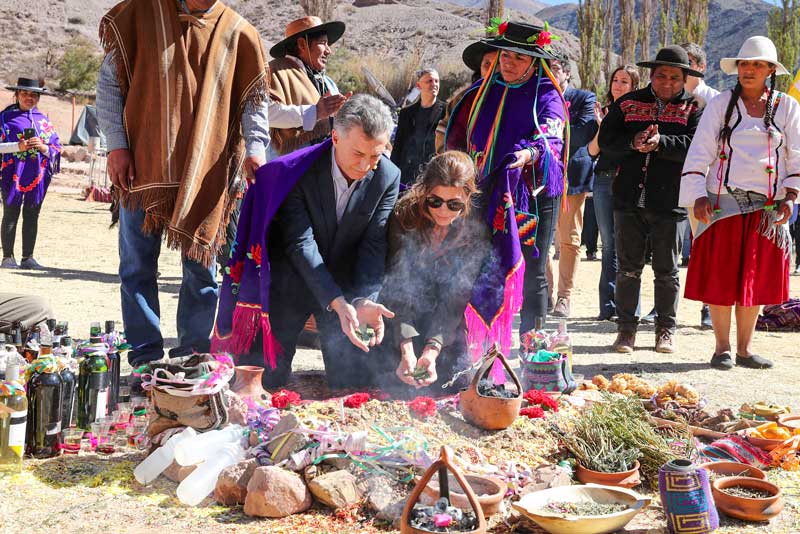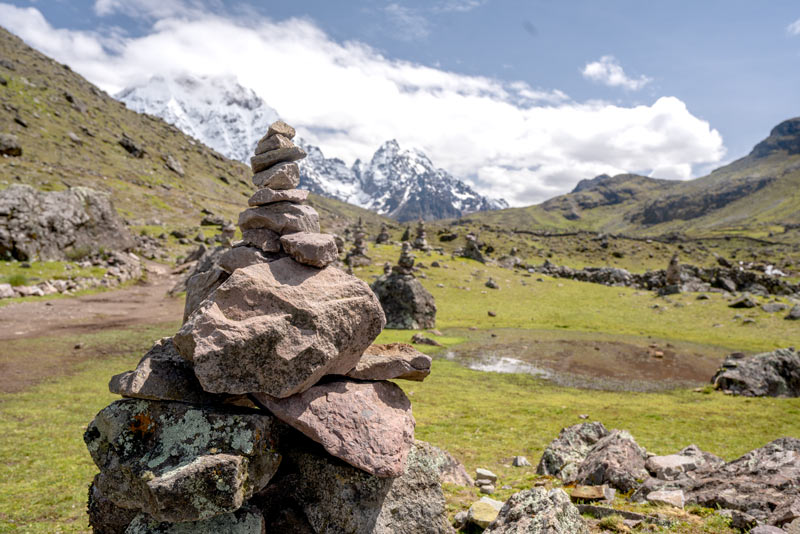Mother Earth Day – Pachamama
In Andean culture, the earth is considered a deity, bringing prosperity to a people through harvests and the bounty of nature. From pre-Inca cultures to the present day, its value remains present, which is why “Pachamama Raymi” is celebrated every August 1st. This festival honors Mother Earth, where, through offerings and rituals, all the well-being she brings is reciprocated. Learn more about this important day and the ceremonies held in honor of Pachamama.
- Pachamama – Mother Earth
- What is the celebration of Pachamama Raymi like?
- When is Mother Earth Day?
- What ceremonies are held in honor of Pachamama?
- Pachamama Day in other countries
- Tips and recommendations
- Frequently Asked Questions
Pachamama – Mother Earth
In the Andean worldview, Pachamama, or Mother Earth is conceived as a god capable of bringing fertility and abundance to the land. She also allows us to connect with nature, which helps us understand that nature is also a living being, in need of care and protection, and requires reciprocal treatment.
The significance of Pachamama lies in understanding her in everything around us, her ability to provide strength to a culture through its agriculture, given that she is nature itself. This is why many rituals and ceremonies are practiced in her honor, allowing people to pay homage to her and thank her for the balance and harmony she brings.
What is the celebration of Pachamama Raymi like?
The most important festival honoring Mother Earth is Pachamama Raymi, a festival celebrated annually on August 1st in the towns of many Andean territories, from Peru to countries like Argentina, Bolivia, Chile, and Ecuador. It is a day that brings together entire communities and families to give thanks and ask for Mother Earth’s blessing.
The rituals are based on the principle of reciprocity called “Ayni,” where one offers favors in the hope of one day receiving the same gratitude.
Offices – Payment to the Earth
The main ceremony held in honor of Pachamama is the offering to the earth. This ritual is conducted by an Andean priest and consists of offerings on a blanket, which is later buried or burned. Among the main offerings offered are coca, chicha, corn, products from the crop itself, some symbolic objects, and sometimes even animal fetuses.
This ceremony brings people together, and in a joint prayer, they ask for the prosperity of the land, as well as thank it for all the well-being it provides. Paying respect to the earth is not only practiced on Mother Earth Day, but can also be done on other occasions to pray for the blessing of the land, for health, among other reasons.
When is Mother Earth Day?
Pachamama Day is held on August 1st, a day in which the fervor of reciprocity is present in every community that still preserves this ancestral knowledge and which allows us to learn a greater sense of humility, in which we understand the value of nature and how each person must also contribute to its care and protection, thus creating a sense of harmony where everyone lives in balance.
On this day, houses are also decorated and blessed with yellow decorations, which are believed to bring good fortune from Mother Earth.
Andean Deities
Within the Andean worldview, each natural being possesses a divine spirit, which can bring prosperity or unrest to a land. Among the principal deities are: Mother Earth (Pachamama), the Sun (Inti), Mother Moon (Mama Quilla), the Goddess of Water (Mama Cocha), and the God of Lightning and Storms (Illapa). They also paid special homage to animals such as the puma, the condor, and the snake.
What ceremonies are held in honor of Pachamama?
Ceremonies and rituals are held in her honor not only on Mother Earth Day; throughout the year, various forms of tribute to this deity are expressed, demonstrating the constant value and presence of Pachamama in the Andean community. Among the most important ceremonies are:
- Challa is a small tribute that is more commonplace and can be used simply. Challa consists of pouring a little of your drink before drinking it. This represents the symbolic way in which one shares their drink with Mother Earth.
- Apacheta are stone mounds left along the way by travelers or community members as a sign of respect and blessing to Mother Earth. Apachetas typically have more than four layers of stones where people leave small offerings, such as coca leaves, alcohol, or even a cigarette, to “feed” the earth.
- Kintu , this ritual is performed by gathering three coca leaves, which symbolize the three worlds of the Andean worldview. The kintu is placed in the shape of a flower and then, after requests (for blessings, protection, or good harvests), they are offered to the mountain spirits and Pachamama.
- Spiritual cleansing is a more symbolic ritual in which medicinal herbs or tobacco are burned as part of a cleansing process and to nourish the earth with sacred smoke. The smoke is often conceived as a bridge between the worlds, where the incinerated food or product ascends to the heavenly realm, carrying the petitions and tribute it represents.
Pachamama Day in other countries
| Country | Main Date | Celebration | Characteristics |
|---|---|---|---|
| Bolivia | August 1st | Offerings of coca leaves, chicha, sweets, alcohol, and colored wool. The offering is buried in a collective ritual (payment to the earth). | It is the most widespread and recognized celebration. It involves entire communities, both rural and urban. |
| Peru | August 1st / All of August | Payment to the Earth: Andean rituals where coca, corn, alcohol, sweets, wool, and even animal fetuses are offered. | Very popular in Cusco, Puno, Ayacucho, and Quechua and Aymara communities. It is often combined with Catholic rituals. |
| Argentina | August 1st | Traditional drink with rue, incense, prayers, and thanks to the land. | Especially strong in Jujuy, Salta, and Tucumán. It blends with Creole and gaucho traditions. |
| Chili | August 1st | Mapuche and Aymara ceremonies: thanksgiving, offerings, songs and dances. | Mainly in the north (Arica and Parinacota region). Fusion with local rites. |
| Ecuador | August 1st | Pamba mesa (community table), indigenous rituals in honor of the land, dances, symbolic offerings. | It is intertwined with the Kichwa cultural worldview and festivities such as Inti Raymi. |
Tips and recommendations
To ensure a more immersive experience celebrating Pachamama Day, filled with rituals and celebrations, we’ll provide you with a series of tips that will help you feel better prepared and informed when participating in this celebration in honor of Mother Earth.
- Keep your mind open to what’s different and learn new things; much of what you see and hear will be very surprising.
- The payment to the earth must always be made by an Andean priest; it is a ceremony charged with great energy and symbolic value that must be respected at all times.
- Participate in rituals and celebrations that will immerse you in a deeper understanding of the importance of Pachamama and how she is honored.
- Visit communities in Cusco on August 1st for a more authentic experience honoring Mother Earth.
- Visit places that promote ecotourism; they tend to be places that live in greater harmony with the land and nature. (Experiential and community-based tourism in Cusco).
- Maintain a constant attitude of gratitude toward the Earth for everything you’ve experienced on your journey. This will enrich your experience and make you feel more present.
- Acclimatization is essential for visiting high Andean communities in Cusco. Try to spend at least a couple of days there before venturing to higher altitudes.
- During the month of August, Cusco is the dry season (April to October), so you’ll find clear, colorful landscapes. Although it can also be quite cold, remember to dress warmly throughout your outings.
- These Andean rituals and ceremonies have been practiced in these lands long before the Inca culture.
- Always remember to preserve and reciprocate with nature, just as they do in Andean culture. It’s a way of living in harmony, conscious of its importance and value.
Frequently Asked Questions
1) What does Pachamama mean to Andean culture?
Pachamama is the representation of Mother Earth within the Andean worldview. She is seen as a sacred living being who provides nourishment, health, and protection, and therefore deserves respect, care, and reciprocity.
2) Why is Pachamama Day celebrated on August 1st?
August 1st marks the beginning of the most difficult month of the year for harvests, which is why it is celebrated as a way of giving thanks and praying for fertility, well-being, and protection for what is to come.
3) How is Pachamama Day celebrated?
It is celebrated with rituals and offerings to the earth. Tributes are prepared with food, coca leaves, chicha, sweets, and other items, which are buried as a symbolic act of retribution and gratitude.
4) What is the “Payment to the Earth”?
The Pago a la Tierra (Payment to the Earth) is an ancestral ritual in which various offerings are made to Pachamama. These offerings are buried or burned as a way of returning what has been received and also pray for health, prosperity, and harmony.
5) Who can participate in these ceremonies?
Anyone who respects and values these traditions can participate. We recommend participating alongside Andean priests who understand the true spiritual and symbolic meaning of the rituals.
6) What kind of offerings are made to Pachamama?
Offerings vary, but commonly include coca leaves, chicha, sweets, cereals, colored wool, seeds, wine, and sometimes animal fetuses.
7) In which countries is Pachamama Day celebrated?
Mainly in Peru, Bolivia, Argentina, Chile, and Ecuador. Although practices may vary, the meaning is always the same.
8) What does the act of burying the offerings symbolize?
Burying offerings symbolizes giving back to the earth what it has given us. It is a gesture of humility, gratitude, and a deep connection with nature.
9) How can I prepare to participate in these ceremonies?
Go with an open, humble, and respectful attitude. Listen to the locals, follow their instructions, and participate with gratitude.
10) What lessons can we learn from Pachamama Day?
It teaches us that the earth is a living being that we must care for, respect, and be grateful for. It reminds us that reciprocity and balance with nature are essential for living in harmony.
Advice from people who have been there
 By: Dennis B.
By: Dennis B.“Advice on how to go to Moray“
“All very nice, but you walk quite a bit in the sun, so bring a hat and water. The place is impressive, the pictures are amazing. If you can, go early, there are less people and you can enjoy it more.“
By Ticket Machu Picchu – Last updated, July 17, 2025



